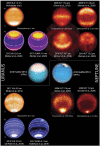Ice Giant Circulation Patterns: Implications for Atmospheric Probes
- PMID: 32165773
- PMCID: PMC7040070
- DOI: 10.1007/s11214-020-00646-1
Ice Giant Circulation Patterns: Implications for Atmospheric Probes
Abstract
Atmospheric circulation patterns derived from multi-spectral remote sensing can serve as a guide for choosing a suitable entry location for a future in situ probe mission to the Ice Giants. Since the Voyager-2 flybys in the 1980s, three decades of observations from ground- and space-based observatories have generated a picture of Ice Giant circulation that is complex, perplexing, and altogether unlike that seen on the Gas Giants. This review seeks to reconcile the various competing circulation patterns from an observational perspective, accounting for spatially-resolved measurements of: zonal albedo contrasts and banded appearances; cloud-tracked zonal winds; temperature and para-H2 measurements above the condensate clouds; and equator-to-pole contrasts in condensable volatiles (methane, ammonia, and hydrogen sulphide) in the deeper troposphere. These observations identify three distinct latitude domains: an equatorial domain of deep upwelling and upper-tropospheric subsidence, potentially bounded by peaks in the retrograde zonal jet and analogous to Jovian cyclonic belts; a mid-latitude transitional domain of upper-tropospheric upwelling, vigorous cloud activity, analogous to Jovian anticyclonic zones; and a polar domain of strong subsidence, volatile depletion, and small-scale (and potentially seasonally-variable) convective activity. Taken together, the multi-wavelength observations suggest a tiered structure of stacked circulation cells (at least two in the troposphere and one in the stratosphere), potentially separated in the vertical by (i) strong molecular weight gradients associated with cloud condensation, and by (ii) transitions from a thermally-direct circulation regime at depth to a wave- and radiative-driven circulation regime at high altitude. The inferred circulation can be tested in the coming decade by 3D numerical simulations of the atmosphere, and by observations from future world-class facilities. The carrier spacecraft for any probe entry mission must ultimately carry a suite of remote-sensing instruments capable of fully constraining the atmospheric motions at the probe descent location.
Keywords: Atmospheres; Dynamics; Giant planets.
© The Author(s) 2020.
Figures








References
-
- Achterberg R.K., Conrath B.J., Gierasch P.J. Cassini CIRS retrievals of ammonia in Jupiter’s upper troposphere. Icarus. 2006;182:169–180. doi: 10.1016/j.icarus.2005.12.020. - DOI
-
- Andrews D.G., Holton J.R., Leovy C.B. Middle Atmosphere Dynamics. New York: Academic Press; 1987.
-
- Atreya S.K., Ponthieu J.J. Photolysis of methane and the ionosphere of Uranus. Planet. Space Sci. 1983;31:939–944. doi: 10.1016/0032-0633(83)90149-6. - DOI
-
- Atreya S.K., Romani P.N. Photochemistry and clouds of Jupiter. In: Hunt G.E., editor. Saturn and Uranus. 1985. pp. 17–68.
Publication types
LinkOut - more resources
Full Text Sources
